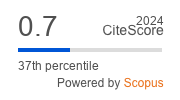Comparison Between Different DNA and Conventional
Keywords:
sperm, comet extent, % DNA in tail, tail moment and olive momentAbstract
Background: The discriminative power of the classical WHO parameters in relation to male fertility is quite low, because they only address few aspects of sperm quality and function. This has led investigators to focus their attention on the male gamete and in particular its genome.Objective: To explore which of the sperm DNA damage parameters measured by comet assay are more reliable, and their relations with the standard semen parameters.Methods: Study was done on 40 infertile men selected from couples attending the Institute of Embryo Reasearch and Infertility Treatment at Al-Kadhimiya City/ Baghdad in the period between February 2009 and May 2009, with a history of infertility of ≥1 years; and 15 healthy volunteers of proven fertility serving as control. Samples were allowed to liquefy for at least 30 minutes at 37°C and then evaluated according to the guidelines of the World Health Organization, 1999. The single cell gel electrophoresis (comet) assay was studied in the ejaculated spermatozoa. The exclusion criteria were the presence of azoospermia and severe oligospermia. Results were compared with the standard semen characteristics (concentration, motility and morphology).Results: Compared to healthy volunteers, infertile patients had highly significantly higher values of comet parameters (P = 0.00001). In all infertile patients, comet extent did not correlate with any of the classical semen parameters; whereas, tail length (μm), % DNA in tail, tail moment and olive moment had all significant negative correlations with the standard parameters. Significant positive correlations were observed between the studied comet parameters, except for the comet extent which was not significantly correlated with tail length and % DNA in tail (P = 0.06, P = 0.7; respectively).Conclusion: Comet assay is a very useful technique in assessing sperm DNA damage. Comet tail parameters and comet extent, may clarify different aspects of DNA damage, and together give a better insight to the integrity of the male genome.Keywards: sperm, comet extent, % DNA in tail, tail moment and olive moment













